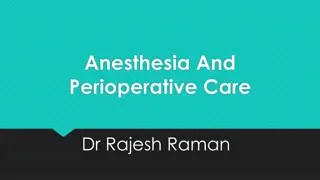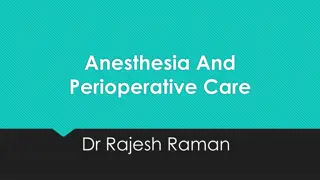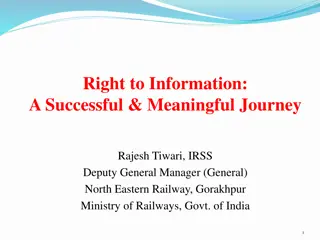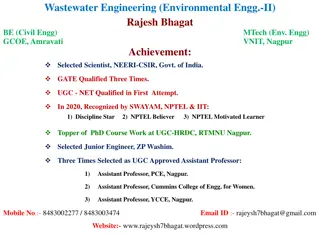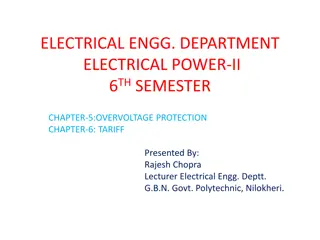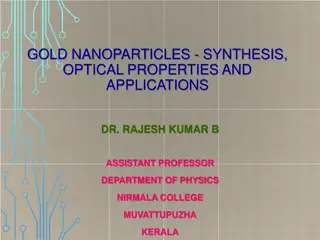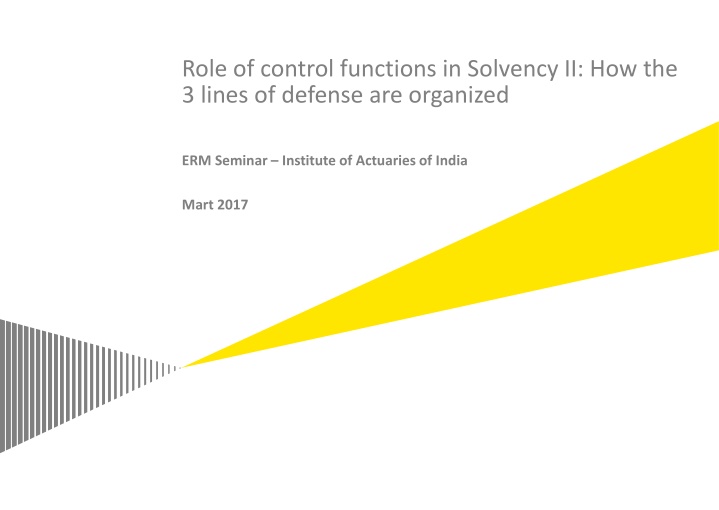
Control Functions in Solvency II: Organizing the 3 Lines of Defense ERM Seminar Insights
Explore the role of control functions in Solvency II and how the 3 lines of defense are structured, as discussed in an ERM seminar by the Institute of Actuaries of India. The classical model of 3 lines of defense and the risk management functions within the framework are detailed, emphasizing the importance of risk ownership, internal control, and audit functions in managing business operations effectively.
Download Presentation

Please find below an Image/Link to download the presentation.
The content on the website is provided AS IS for your information and personal use only. It may not be sold, licensed, or shared on other websites without obtaining consent from the author. If you encounter any issues during the download, it is possible that the publisher has removed the file from their server.
You are allowed to download the files provided on this website for personal or commercial use, subject to the condition that they are used lawfully. All files are the property of their respective owners.
The content on the website is provided AS IS for your information and personal use only. It may not be sold, licensed, or shared on other websites without obtaining consent from the author.
E N D
Presentation Transcript
Role of control functions in Solvency II: How the 3 lines of defense are organized ERM Seminar Institute of Actuaries of India Mart 2017
Solvency II Lines of defence model Business operations (Risk ownership) The business operation units are to measure and manage business performance, implement internal control and risk management framework 1 Risk and control functions Risk mgmt function Facilitate the Risk Management system: System of governance, ORSA, SCR calculation Actuarial function Coordinate calculation of provisions Contribute to risk management system Compliance function Facilitate and evaluate internal control processes Contribute to risk management system 2 Internal and external audit Provide independent and objective assurance over the effectiveness of corporate standards and business compliance, including that the risk management system functions 3
Solvency II Risk Management Connect business strategy to risk decisions and operational processes
Solvency II System of Governance Source:MunichRE
Role of Risk Function (Article 44) Structured in such a way to facilitate the implementation of risk management system Strategies, processes and reporting procedures necessary to continuously identify, measure, monitor, manage and report incurred and potential risks and their interdependencies at an individual and at an aggregated level. Should cover at least the following areas risk assumption and reserving, asset liability management, investments especially derivatives, liquidity and concentration risk, management of operational risk, reinsurance and other risk mitigation technique Thus it should do the following: Overall coordination and control of the riskmanagement tasks Measurement and assessment of the overall risk situation, including early identification of potential future risks Reporting to the Board 1. 2. 3.
Role of Compliance Function (Article 46) Structured in such a way to facilitate the compliance with internal control system Should cover at least the following areas Administrative and accounting procedures, Internal control framework, Appropriate reporting arrangements at all levels in the company Thus it should do the following: Supervision of the internal control system Risk Control Early Warning Provision of advice to management 1. 2. 3. 4.
Role of Internal Audit Function (Article 47) Responsibilities include - evaluation of the adequacy and effectiveness of the internal control system and other elements of the system of governance Audit report to be produced at least annually
Role of Actuarial Function (Article 48) Responsibilities include -Coordination and monitoring of the evaluation of technical provisions (including methodology, assumptions and data), Reporting and Supporting the risk management function The function is not responsible for calculating the technical provisions, but for coordinating the calculation process and assessing the methods, tools and data used for the evaluation Responsibilities include To understand the individual model components, their interdependencies and the way the model depicts and takes account of the resultant diversification effects To develop and regularly review the reserving methodology (stochastic simulation, deterministic approach, etc.) To compare the current assumptions with those for the previous year and those for the previous year with the actual figures to calculate the technical provisions (bestesti mate comparison), and identify the reasons for the variances To express opinion on reserving and underwriting guidelines To express opiinion on reinsurance cover, adequacy of premiums, main risk factors and their influence on next year profit, appropriatenes of IT system 1. 2. 3. 4. 5. 6.
Interfaces between key functions Source:MunichRE

